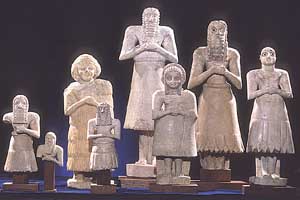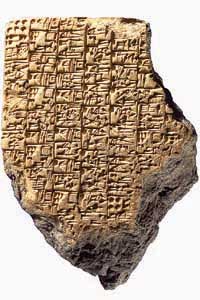Origin of civilization’s birth in the spotlight at Oriental Institute: Edgar and Deborah Jannotta Mesopotamian Gallery will open Oct. 18
By William HarmsNews Office
 Gil Stein, Director of the Oriental Institute, McGuire Gibson, Professor in the Oriental Institute and Near Eastern Languages & Civilizations, and their guest Donnie George, director of research for the Iraqi State Board of Antiquities, speak at a press conference held in the new Edgar and Deborah Jannotta Mesopotamian Gallery. George visited the gallery and provided the media with new information on the status of objects stolen from the National Museum in Iraq. George thanked Gibson and other scholars in the Oriental Institute for helping to search for and protect retrieved artifacts from the Iraq Museum. Many of the artifacts that were stolen during the looting were excavated by Chicago archaeologists. |
This gallery joins two others that recently opened at the Oriental Institute Museum and which feature the cultures of ancient Egypt and Persia.
“The recent events in Iraq have increased the world’s appreciation of the incredible ancient heritage of Iraq,” said Gil Stein, Director of the Oriental Institute. “We are proud to have played a key role in bringing the world’s attention to that heritage and are delighted to be able to share the many fine objects from our own Mesopotamian collection with the public through the opening of this new gallery. These statues, monumental sculptures and items from everyday life help us appreciate the skills and imagination of the people who made up the great ancient cultures of the region.”
Stein noted that ancient Mesopotamians’ contributions to modern life include writing, cities, government, mathematics, literature and the wheel. “Even now, 5,000 years later, they still structure almost every aspect of our everyday lives,” Stein added. “We hope that visitors to our Mesopotamian Gallery will come away with a deeper appreciation for both the tremendous accomplishments of that ancient civilization and for its fundamental role in defining who we are today.”
Computers programmed with information to help visitors learn about the Oriental Institute and its collection will be located in the gallery, as will displays that explain how Oriental Institute scholars have conducted their research since the end of the 19th century until today.
Oriental Institute archaeologists, many of them pioneers in this field and many who continue today to be leaders in the discipline, excavated most of the material on exhibition.
 These praying male and female statues, made of gypsum, date back to about 2750-2500 B.C. They were found in the Diyala Region and were excavated by the Oriental Institute. |
“The gallery documents the powerful sweep of the rise and growth of civilization in the region—from its foundations in prehistoric times, through the glories of the city-states at the time of Ur, to the great empires of Babylonia and Assyria, and on into the 7th century A.D.,” she said.
At the far end of the gallery, opposite the visitor’s center, is the most spectacular object in the Mesopotamian collection—a human-headed winged bull that stands 16 feet tall. The statue, known by many Chicagoans as the “Assyrian Bull,” is one of the museum’s most popular items and gains splendor in a new setting that calls attention to its original architectural purpose.
Six 10-foot stone reliefs from the throne-room facade in the palace of the Assyrian king Sargon II (who ruled from 721 to 705 B.C.), flank the bull statue. Oriental Institute archaeologists excavated the bull and the reliefs at Sargon II’s capital city Dur-Sharrukin, known today as Khorsabad. This stunning new installation, the Yelda Khorsabad Court, which is the result of more than 10 years of work, evokes the feeling of grandeur and power of the palaces and temples of the mighty Assyrian Empire.
The Mesopotamian gallery provides visitors a chance to explore the ancient Near East in chronological fashion. The first section of the exhibition is devoted to the prehistory of Iraq. The Robert and Linda Braidwood Prehistory Exhibition highlights the work of these two pioneering Oriental Institute archaeologists, who began their research in the years just following World War II. It takes visitors back 150,000 years and follows the development of human society from nomadic groups to settled farming villages.
Ancient Mesopotamia, the land between the Tigris and Euphrates rivers, was a land of cities. The gallery displays a wealth of objects from what may be the world’s first urban civilization, including pottery, clay tablets, stone sculptures, and vessels made of luxurious stones and metals.
The ancient Mesopotamians began writing as a way to record commercial transactions, but quickly developed a rich written tradition that included literature, mathematics and science. Displays trace the development of writing on clay tablets, the training of scribes in ancient schools, and the tradition of royal inscriptions on clay, stone and metal.
The region’s lively commercial life was enhanced by the use of small, intricately carved stone seals, made in the shape of cylinders that could be rolled across clay sealing doorways or containers to identify the individual or administrative unit that had impressed the seal. The decoration of these seals includes combats between fantastic heroes and wild animals, scenes of worship, and images of lions and other animals common to the region. A new series of display cases has been created to show the museum’s extensive collection of these precious seals.
Religion played an important part in the life of ancient Mesopotamians. Each city boasted at least one temple dedicated to its patron god or goddess. During the third millennium B.C., devotees dedicated statues and placed them in these temples to stand in perpetual prayer before the altar. The Oriental Institute has the best collection of these votive figures outside of Baghdad. The finest statues from the museum collection are on display, standing with large staring eyes and hands clasped in prayer.
 |
“Beneath the beauty of these pieces is a heritage of technological expertise and invention,” said Wilson. “The ancient Mesopotamians mastered numerous complex techniques to produce magnificent objects, ranging in size from tiny cylinder seals to monumental sculptures. They created these amazing works of art that have endured for thousands of years and are what make the gallery so engaging.”
Admission to the Oriental Institute Museum at 1155 E. 58th St. is free, and donations are welcome. The museum is open Tuesday, Thursday, Friday and Saturday from 10 a.m. to 4 p.m.; Wednesdays, 10 a.m. to 8:30 p.m., and Sundays noon to 4 p.m. For more information, call (773) 702-9514.
![[Chronicle]](/images/sidebar_header_oct06.gif)